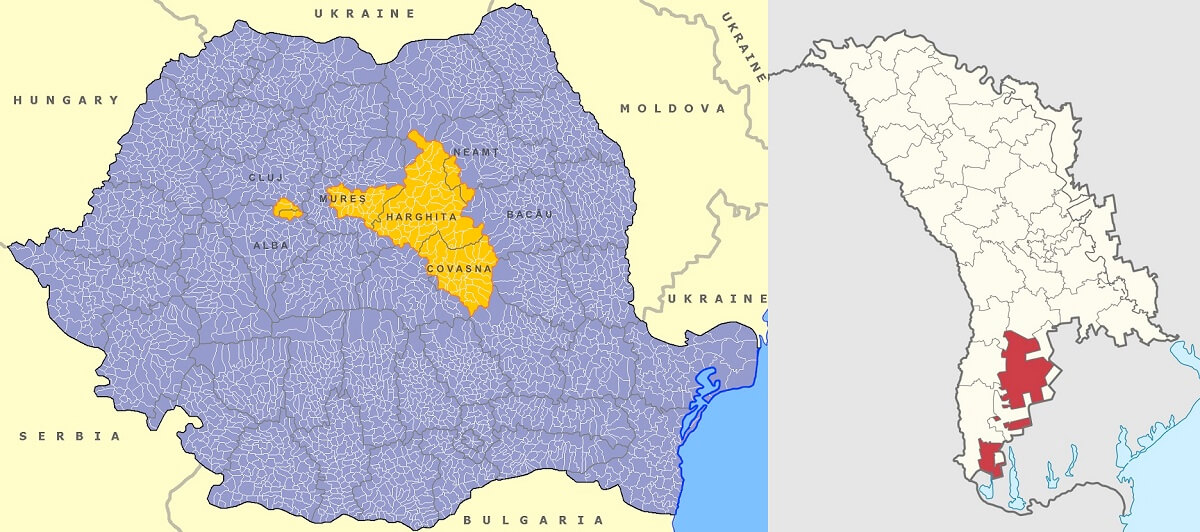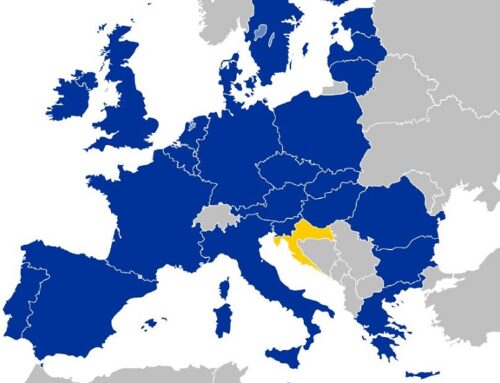Introduction
In nowadays the situation in the Crimea, in addition to the still unresolved ethnic crisis in Ukraine is a very important phenomenon for several reasons. For an example it’s very rare when a state is neglecting a signed international treaty (in this case this happened with the Budapest Memorandum which should needs to secure the territorial integrity of Ukraine), but other events are also important because Russia claims and justify these actions by the protection of the Russian- speaking people (in the Crimea Peninsula it means the protection of the majority, while in eastern Ukraine the protection of the minority). Moreover it mentions Kosovo as a precedent, although Moscow can not recognize Kosovo’s independence. This argument may could be a catalyzer for other European minorities just like the Hungarians in Transylvania or like the Székely people in Székelyland (Romania). At this moment it’s still difficult to predict whether these events could have got any impact to Székely Land, or if there will be any consequences for Romania, but in this paper I would like to focus on the autonomy model which secures and provides the legitimacy and the rights of a minority in a country with a Romanian-speaking majority.
However firstly important to mention that these impacts may could be negative as well. The new rhetoric of Vladimir Putin which based on the conservative nationalism (supported by the orthodox values) is very attractive (Economist, 2014) for many right wing radical parties in Europe (e.g.: “Front national” in France) and next by the ideological connection Moscow also provides financial support for these parties (Herczeg, 2014). All of these together might lead changes in Székely Land as well, because the support of the Hungarian right wing may result more radical Hungarian groups in Transylvania and this will cause damages in the Hungarian-Romanian relations.
While in the case of a positive scenario the Gagauz autonomy in Moldova could serve as a positive role model and through this could be a peaceful solution for the Székely people as well. Most likely this could happen in the case of the union of Romania and Moldova. Although even if this will happen perhaps only the Russian minority protection will have enough power to influence the Romanian government. Russia probably wouldn’t support the Romanian (and especially not the Ukrainian) annexation of Transnistria but the Russian annexation would be also difficult. So it may be an exclave – just like Kaliningrad which is a very important territory from many aspects with a naval and also with a military base between Poland and Lithuania. But about this complex geopolitical environment the situation of Moldova probably won’t change in the close future. Therefore the situation of the Gagauzians and the Székelys won’t change neither. Still it is important to speak about the Gagauz autonomy because about the previously mentioned scenarios this topic could be crucial in the future.
The roots of the Gagauz autonomy
The majority of the Gagauz people are living in Moldova (mostly in the autonomous Gagauz territory), in Ukraine, in Turkey and in Russia. They are speaking in Gagauz language which belongs to the family of Turkish languages and most of them are Orthodox Christian (Menz, 2006). The idea of the Gagauz autonomy has been appeared as a result of the changes in Moldova and as the result of the Soviet reforms which are initiated by Gorbatchov. After the Moldavian Soviet Socialist Republic in 1989 amended the constitution and the Moldavian became the state language (still they made some gestures towards the people with other mother tongue), it provoked a fierce aversion in the non- Romanian-speaking communities which are living in Moldova included the Gagauz people as well. The Gagauz minority essentially were afraid because this step might paves the way towards the union of Moldova and Romania. The Gagauz people preferred the Soviet (later the Russian) orientation and basically they kept this preference even in nowadays, instead of the unification with Romania. After the Gagauz-Moldovan conflict the idea of the Romanian-Moldovan union was removed from the political agenda temporarily. In the late 1994 the parliament adopted the country’s constitution still in force, which had also creating an autonomous Gagauzia. The autonomous Gagauzia has been created finally by the Parliament of Moldova in the frame of an “Organic Act” (“Act about the Special status of Gagauzia”) with a so-called qualified majority in 1994 (Protsyk, 2010).
The autonomous Gagauzia with the many significant special rights worked for a long time relatively pacified (except some friction and crisis situations) and integrated within the public system of Moldova. In recent years about the rather turbulent domestic politics processes the country’s foreign policy commitment has become a key issue. The question is they want a commitment towards the “West” (EU) or towards the “East” (essentially Russia). In the same time also reappeared in the politics and also in the public speech the possibility of the Romanian-Moldovan unification. Interesting that lately this topic is more frequently appears in the rhetoric of the politicians and the political parties also in Bucharest. Romania is clearly interested in the European integration of Moldova (estimated hundreds of thousands Moldovan citizens possess Romanian citizenship), while Russia is more interested in an independent Moldova oriented towards the “East”. Moldova and the European Union initialed the Association Agreement on the 29th of November in 2013, thus further accelerating the European integration of the country (Gylfason, Wijkman, 2014).
The perspectives of the Gagauz autonomy
Just like thirty years ago, the Gagauz people even today would like to avoid the possible unification of Moldova and Romania and they want a largely pro-Russian foreign policy. Therefore they held a referendum in Gagauzia on February 2 in 2014, where the attendees had to decide in three interrelated issues. The referendum was decisive in one issue (about the legal status of Gagauzia) while in the other two issues the referendum were an opinion poll (about the European integration and about the opening towards the “East”). Gagauzia’s Parliament (People’s Assembly) have been decided about the referendum just right before (by two days) the initialing of the EU-Moldova Association Agreement and adopted at the same time a law which would come into force only in the case of the possible loss of the state sovereignty of Moldova. By the law, if Moldova joins to another state, then Gagauzia immediately became independent and the Gagauz Republic will be created. The turnout was very high (it was a historical record, more than 70 percent of the Gagauzian voters went to the polls). In the end 98.4 percent of those who voted supported the Russia-Belarus-Kazakhstan customs union which has been established in 2010 and 97.2 percent voted against the European integration and supported the opening towards the “East”. Finally 98.9 percent of attendees supported Gagauzia’s right to the independence in case if Moldova loose or renounce their independence (Stratfor; 2014). The Moldovan authorities and the judiciary would have liked to stop the referendum. Two court declared it unconstitutional therefore they banned it and the attorney general has initiated a prosecution because the referendum has been held. The prime minister of Moldova declared the act unlawful after the referendum. The Romanian minister of foreign affairs also had got an opinion. Accorded by Titus Corlatean the “so called” referendum in Gagauzia is null and void and therefore not suitable replacement for any legal effect (Krónika, 2014).
The main point of the legislation which secures the autonomy of Gagauzia is the following: “when a change occurs in the status of the Republic of Moldova as an independent state, the people of Gagauzia have a right to external self-determination.” So for an example if Moldova would be merged with another state then Gagauzia has legally become an independent state. The passage turned to be controversial in Moldova immediately after the adoption of the law, but then the Constitutional Court has not found it unconstitutional (Nielsen, 2016).
Gagauzia fears that Moldova’s entry into the European Union in the medium term means the unification with Romania and that’s going to eliminate the Gagauz autonomy, because Romania does not support the ongoing autonomy efforts (such as the Szekely autonomy) within the Romanian borders. In 2014 the pro-Russian Socialist Party (PSRM), composed of former communists, emerged as the winner of the elections and the strongest party in Parliament, gaining 20.51% of votes. This party does not support the unification of Romania and Moldova’s European integration, but on the other hand they have got a positive attitude towards the Gagauz autonomy referral. The PSRM’s policy is close to Russia’s foreign policy interests, thus according by several researches there would be a significant Russian support behind the current pro Gagauz viewpoint of the PSRM. In overall the whole situation is very similar to the earlier conflict in Ukraine between the Western and Eastern oriented political forces. (Freedom House, 2015).
When Romania’s President spoke with Herman van Rompuy (in that time he was the President of the European Council) he stated if Gagauzia and the Transnistrian Region could jeopardise Moldova’s European integration and if this threat is concretized, then Romania can not remain idle. The Gagauz don’t want to get into the same situation like the Hungarians in Transylvania – as to Mihail Formuzal, head of the Gagauz autonomous region have referred. Instead of the uncertainty (such as the possible loss of the autonomous status) which might be resulted by the European integration their goal is at least to preserve the current situation or maybe to open more towards Russia (Balogh, 2014).
The Romanian public discourse is not mention the Gagauz autonomy, because a unique operating model in a close country like Moldova may could put the question of the Székely autonomy as well in a different (and more favourable) frame. However the potential problems of the Gagauz autonomy could be interpreted as a proof that the autonomy is the first phase of the secession. This would be a negative interpretation from the aspect of the Székelys but the existing Gagauz autonomy much more serve as an example to imagine a national minority autonomy within a state, and this does not jeopardize the unity of the state, contrary to the Transnistrian territory.
Conclusion
The Gagauz autonomy has importance especially in the larger international context, because situation of Moldova is very different compared to Romania. In Moldova the two hundred years of Russian domination resulted a different kind of nationalism. Additionally in the case of independence the Russian action could not be ruled out (e.g.: military aid to Transnistria). Chisinau can’t treat the minorities (especially not the substantial Russian minority), such as Romania. The situation is still sensitive and on the basis of the referendum is not an exaggeration to say that the Russian influence remains strong, and it might be even stronger by time. The Russian foreign policy places great emphasis on Russian communities living outside the country, they keep extensive contacts with them and they often build out a strong (and very radical) local media network. At the same time they are trying to influence its neighbours through them, as happened in the Crimea or Estonia. The results of the Russian language teaching is a strong proof that these kind of influence also has a significant effect on the Gagauz people (Ursu, Coalson, 2011). Russia tries to keep the Moldavian Republic away from the EU (and from the West in general), therefore the Gagauz people used as political tools by Moscow to isolate Moldova. So if it will be essential from the aspect of the foreign policy anytime, they will able to increase their influence within the region, although at this moment rather unlikely that any serious interventions would happen in the near future; especially not before the solution of the Transnistrian conflict.
Paradoxically, the creation of the Székely autonomy could be beneficial in long term for Moldova and Gagauzia, as it would show for the Gagauz people that Romania respects the will of a national minority. The Moldova-Romania merger scenario is feasible even in nowadays, and the stability of the region and the limitation of the Russian expansion is more important for the European community than ever before. Therefore all of the actors shall realise in the region that the autonomy is not destabilise, but much more strengthen the unity of a country.
Works Cited:
Gylfason ,Thorwaldur; Wijkman, Per: Meeting Russia’s challenge to EU’s Eastern Partnership,
http://www.voxeu.org/article/russia-against-eu-s-eastern-partnership (Accessed: 20/07/2020)
Menz, Astrid: “The Gagauz”. In Kuban, Doğan. The Turkic speaking peoples. Prestel, 2006
Pink, Daniel H.: Drive: The Surprising Truth About What Motivates Us. Riverhead hardcover, 2009
Protsyk, Oleh: Gagauz autonomy in Moldova: the real and the virtual in post-Soviet state design, (In: Weller M. Nobbs K (eds) Asymmetric Autonomy As A Tool Of Ethnic Conflict Settlement, Philadelphia: University of Pennsylvania Press)
Stratfor: In Moldova, Gagauzia’s Referendum Illustrates the EU-Russian Struggle, Stratform 2014. https://www.stratfor.com/analysis/moldova-gagauzias-referendum-illustrates-eu-russian-struggle (Accessed: 20/07/2020)
Balogh, Levente: Gagauz vezető bírálta Basescut, Krónika Online, 2014.
http://kronika.ro/kulfold/gagauz-vezeto-biralta-basescut (Accessed: 28/07/2020)
Freedom House: Moldova, Nations in Transit, 2015. https://freedomhouse.org/report/nations- transit/2015/moldova (Accessed: 23/07/2020)
Herczeg, Márk: A Jobbik és Európa szélsőjobboldali pártjai: Putyin nyugati szövetségesei http://444.hu/2014/03/27/a-jobbik-es-europa-szelsojobboldali-partjai-putyin-nyugati- szovetsegesei/ (Accessed: 12/07/2020)
Nielsen, Ann Mette Sander: Gagauzia: Another Obstacle on Moldova’s Path to Europe?, CIPE, 2016. http://www.cipe.org/blog/2016/02/04/gagauzia-another-obstacle-on-moldovas-path-to- europe/#.V55pMzuLTcs (Accessed: 22/07/2020)
Székelyhon: Gagauziát csábítja Moszkva, Krónika Vol. XVI, Issue 60. http://www.szekelyhon.ro/archivum/offline/cikk/195997/gagauziat-csabitja-moszkva (Accessed: 20/07/2020)
The Economist: Russia’s Friends in Black, April/2014, http://www.economist.com/news/europe/21601004-why-europes-populists-and-radicals-admire- vladimir-putin-russias-friends-black (Accessed: 12/07/2020)
Ursu, Valentina; Coalson, Robert: Moldova’s Gagauz Region Struggles to Find Common Language with Chisinau, Radio Free Europe/Radio Liberty, 2011. http://www.rferl.org/content/moldovas_gagauz_autonomous_region_struggles_to_find_a_commo n_language_with_chisinau/24285661.html (Accessed: 29/07/2020)





